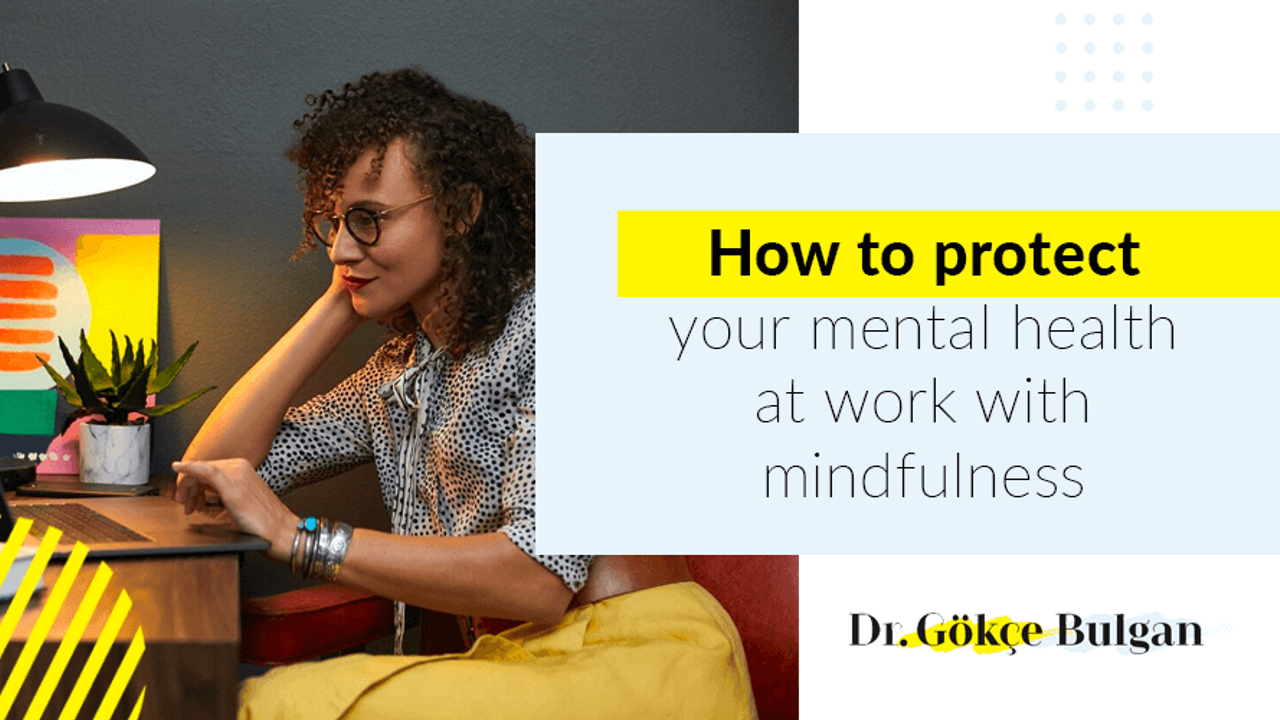How to protect your mental health at work with mindfulness

If you’re struggling with stress or anxiety at work, it’s important to know that you are not alone. Stress and anxiety have increased since the global pandemic, with 55% of people stating that Covid-19 has had a negative impact on their mental health.
If you’re here, reading this, you’ve made that all-important first step to protecting and improving your mental health in the workplace.
In this blog post, I will discuss how you can improve your mental health at work by using mindfulness.
Of course, there are a lot of issues at work that are often out of your control–how your colleagues or managers treat you or how your customers or clients speak to you.
This blog post will focus on the things that are in your control, and the things you can change that will positively impact your mental health. While we can’t control everything, we can control our thoughts, attitudes, and how we respond. And doing this can make a huge impact.
So let’s get started.
What is mindfulness?
Mindfulness is exactly as it sounds. It’s about being aware–or mindful–of what is happening right now, in the present. It’s about understanding our thoughts, body, or environment–without judgment.
It’s helpful in putting distance between yourself and your thoughts, particularly thoughts that cause you stress or anxiety. It gives you the space to reflect on those thoughts and work through them with a calm mind and body.
A bit unsure about mindfulness? You’re not alone.
People tell me that they couldn’t possibly practice mindfulness because they’re not a ‘spiritual person’. Or they don’t see how they can apply mindfulness in their day-to-day lives, especially while they are at work.
But you don’t have to be spiritual to practice mindfulness. All the mindfulness practices that I will share with you in this blog post are research-based and secular in nature. And you can implement mindful activities quite easily in your day-to-day work life. (I’m going to come onto that a bit later.)
Some people think mindfulness sounds a bit ‘fluffy’ and doesn’t really deliver results. But actually, there’s plenty of scientific evidence of the health benefits of mindfulness.
Mindfulness is also practiced by many business leaders too, such as Bill Ford (the executive chairman of Ford Motors) and Marc Benioff (founder of Salesforce).
Finally, the biggest objection people have to mindfulness is that it can feel counter-intuitive. When you’re busy and stressed, there’s a temptation to keep going. BUT, when we’re working under stress, we’re likely to make mistakes, which leads to, yes, you guessed it, even more stress! This is why taking just a few minutes to practice mindfulness can make a huge difference.
Ultimately, mindfulness is a simple, cost-effective way of protecting your mental health both in and out of work.
What are the benefits of mindfulness in the workplace?
If you practice mindfulness in the workplace, you can:
- Reduce stress and anxiety
- Improve heart rate and lower blood pressure
- Increase productivity
- Boost your memory
- Think more clearly and solve problems faster
The question is, how do you practice mindfulness, and how can you use it to protect and improve your mental health?
Below, I go through some simple ways of practicing mindfulness at work.
How to practice mindfulness throughout your workday
1. Practice mindful meditation at work

No, you don’t need a studio, yoga mat, and an hour to spare to practice mindful meditation at work.
You simply need the intention to practice it, anywhere and anytime. Some people think that they’d only be able to practice mindfulness in a quiet space. And they end up never finding that place throughout their day.
You could simply practice mindfulness in the middle of your busy day by taking three mindful breaths and observing how that feels. We call these in-the-moment practices, ones that are integrated into our daily lives.
For those of you who would like to dedicate more time to practicing regularly, you could simply start by sitting down for a couple of minutes and silently counting your inhales and exhales. You could start at one and go up to ten, or whatever number you like. Whenever you get distracted, gently bring your attention back to your breath. So, the only thing you actually need is the intention to practice.
For those new to mindfulness, you could use an app to help you. The Calm app is one of the most popular, and they have a ‘mindfulness at work’ series you can use. Each session is just ten minutes long. Pop in your earphones and follow the instructions.
Afterward, you’ll find that you’re more relaxed, less stressed, and able to think more clearly. And eventually, you’ll learn how to practice mindfulness throughout your day without needing your own space. You’ll be able to do it anytime, anywhere.
2. Change your perception of stress

Did you know that how you view stress could be more damaging to your health than actually experiencing stress? A study by Harvard University showed that individuals who view stress positively have fewer negative health symptoms than those who view stress as debilitating.
To reduce the negative impacts of stress, we have to change our mindset towards stress. Try not to see it as ‘bad’ and instead, see it as useful.
When you experience stress and the physical symptoms that come with it (increase in heart rate, anxious thoughts, that upside-down feeling in your stomach), take a minute to become aware of these feelings.
Understand that these symptoms aren’t bad; in fact, they’re there to prepare you for the challenge ahead. They are useful.
Dr. Kelly McGonigal advises you to think of stress as energizing– designed to give us the energy to overcome a challenge. And to view nervousness as a sign of how much we care about something.
We can’t avoid all uncomfortable or stressful situations in our lives (otherwise, we wouldn’t do very much), but we can control how we view stress. Stress can help us achieve our goals. This doesn’t mean that I wish more stress for anyone—it’s to emphasize how we view stress makes a difference. Therefore, in situations where you cannot avoid stress, perceiving it as useful rather than harmful would be the way to go.
3. Take a mindful walk

Mindful walking is simply the act of walking while being aware of your body and surroundings. When you take your lunch break, try getting outside for a short walk. Even ten minutes can make a huge difference.
As you walk, pay attention to your body. How do your shoulders feel? Are they high up? How does your neck feel? How do your arms swing? How does the ground feel beneath your feet? There’s no need to change anything. Just pay attention to these things.
Also, make a note of your surroundings and appreciate the little things. A lot of us aren’t lucky enough to work at the beach or in the middle of a forest, but that doesn’t mean we can’t spot beauty in all sorts of places.
Doing this helps ground us. It brings us out of our thoughts and gets us to focus on something else. This means that by the time you get back to your desk, you’ll have that clear-headed feeling that will help you tackle any tasks ahead.
4. Make note of the positives

We naturally pay more attention to things that are ‘negative’. That’s why, when we receive a performance review from our manager, we focus on the ‘areas to improve’ rather than the compliments about our performance.
We are evolutionarily wired to perceive ‘negative’ experiences more than ‘positive’ ones. It’s a survival mechanism. This negativity bias can impact our stress and anxiety.
At the end of each day, jot down some of the positives that happened while you were at work. This could be a colleague making you laugh. Or a customer thanking you for your hard work. Or getting a difficult task out of the way.
There are jobs I’ve certainly loved more than others! But for every job I’ve had, there have always been positives. Find them, and focus on them. It really does work!
It’s also good to look back on these notes when you’re having days that feel really tough. They’ll remind you that not every day is like that.
5. Fully immerse yourself in the task at hand

If there’s one thing that can impact our mental health, it’s feeling overwhelmed. I’ve been there myself, with 50+ tabs open on my computer (maybe that’s you right now!), jumping from one task to the next. Never quite getting anything done but feeling like you’re going a hundred miles an hour.
This is why it’s best to close everything down, including your emails and Slack (or whatever tools you use), and immerse yourself in one task and nothing else. Intend to deal with one task at a time by telling yourself, ‘This is the one thing I will prioritize right now.’ Imagine how it would feel getting it done.
You can use something like the Pomodoro® Technique to help you. This is where you pick a task, set a 25-minute timer, and work solidly on that task alone–shutting down any other distractions.
The Pomodoro Technique works well because, yes, it gets us to concentrate, but it also forces us to take a dedicated break after a certain period of time. You can use that time to do some of the things I listed above, such as going for a walk or doing a mindfulness meditation. You’ll be surprised at just how effective it is at reducing anxiety around tasks, making you more productive, and giving you more time to relax.
What’s next for you?
I hope that helped you. To start, pick one of the five tools above and try to implement them in your workday. Gradually start adding more and more until you’re doing all five of these every day. I promise it will make a huge difference.
And if you’re looking for further support with mindfulness-based well-being for your team, please have a look at my interactive mindfulness workshops aimed at leaders and teams.

